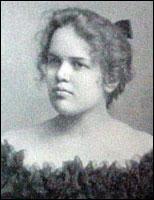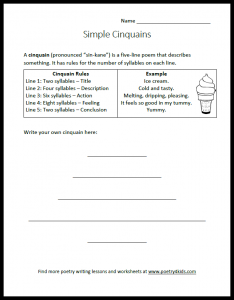What is a Cinquain?

Adelaide Crapsey, American poet and creator of the modern cinquain
A cinquain – which, by the way, is pronounced “sin-cane,” not “sin-kwane” – is a form of poetry that is very popular because of its simplicity. It was created by American poet Adelaide Crapsey about 100 years ago, and is similar to Japanese poetic forms, such as haiku and tanka.
Cinquains are just five lines long, with only a few words on each line, making them easy to write. The first and last lines have just two syllables, while the middle lines have more, so they end up with a diamond-like shape, similar to the poetic form called the diamante.
Though they are just five lines long, the best cinquains tell a small story. Instead of just having descriptive words, they may also have an action (something happening), a feeling caused by the action, and a conclusion or ending.
You can learn to write cinquains by following these few simple steps:
- Decide what you would like to write about.
- Brainstorm words and phrases that have to do with your idea.
- Think about what story you want to tell.
- Write your words and phrases in an order that tells your story, being sure to count the syllables as you go.
The Rules of a Cinquain
There are actually many different ways to write a cinquain, so I’m just going to teach you how to write a traditional cinquain, as it was defined by the poet who invented it. These are the rules:
- Cinquains are five lines long.
- They have 2 syllables in the first line, 4 in the second, 6 in the third, 8 in the fourth line, and just 2 in the last line.
- Cinquains do not need to rhyme, but you can include rhymes if you want to.
That’s it. Just three simple rules.
If you want to, you can even memorize the syllable count by remembering this five-digit number: 24682. Repeat after me: 24682, 24682, 24682. Now you’ve got it.
Getting Started
First, you need to select a topic. That is, you need to choose something to write your cinquain about. Here are a few easy places to get ideas:
- Write about your favorite thing
- Write about something you don’t like
- Write about something you see around you
- Write about something that happens to you
Since I like ice cream, I think I’ll write a cinquain about ice cream. This is convenient since the words “ice cream” have two syllables, so I can probably use this phrase as the first line of my cinquain. If your favorite thing is pizza, soccer, your cat, etc., you could also use “soccer,” “pizza,” or “my cat” as the first line of your cinquain.
Brainstorming ideas
Once you know what you are going to write about, you need to brainstorm ideas about your topic. Think of as many things as you can and write them down on a piece of paper. It’s okay to write your ideas on one piece of paper and then write your poem on another piece of paper.
For example, I know several things about ice cream, so I’ve put them down here:
- It is cold.
- It is yummy.
- It is sweet.
- I like eating it.
These are just four ideas, but they are not yet a poem. To turn these ideas into a cinquain poem, we need to say them in a way that we have five lines with the right number of syllables on each line.
Counting Your Syllables
I recommend your count your syllables with your fingers as you write each line. If a line has too many syllables or not enough syllables, see if you can change some of the words to get the right number of syllables.
Once you get the syllable count right, make sure the poem says what you want it to say. You may need to go back and change it some more so that it tells the story you want it to.
Once your cinquain is finished, read it again, counting the syllables on your fingers to make sure you got everything right.
Ice Cream Cinquain
Here’s a cinquain that I wrote about ice cream, using the ideas that I brainstormed earlier:
Ice Cream
Ice cream.
Cold and yummy.
I love its sweet richness
as it finds its way into my
tummy.
You might notice a few things about this poem. It tells a little story. There is an action in which I eat the ice cream and it swallow it. There is a feeling expressed where I tell that I love it. And I even rhymed “yummy” with “tummy.”
Messy Room Cinquain
Let’s try another one. This time, let’s write a cinquain about having a messy room. First, we need to brainstorm ideas. Here are a few I came up with:
- Dirty laundry
- Toys all over the place
- Mom says “clean it up”
- The hamper is overflowing
- I’d rather watch TV than clean my room
- I don’t mind my own mess
I don’t have to use all of these ideas, but writing more ideas than I am going to actually use give me lots to choose from when I start writing the poem.
Now that I’ve got my ideas, I’ll rearrange these into a five-line story with a 24682 syllable pattern, like this:
My Messy Room
My room
is such a mess.
Toys all over the place.
Mom says, “Clean up!” But I like it
like this.
Telling a Story with Your Cinquain
I mentioned earlier that the best cinquains tell a story. An easy way to do this is to start with your subject on the first line, describe it on the second, put an action on the third line, a feeling on the fourth line, and a conclusion on the last line, like this:
Title
Subject
Description
Action
Feeling
Conclusion
You don’t have to follow this pattern exactly. For example, in the Messy Room cinquain, you’ll see that my description is on lines 2 and 3, and both the action and the feeling are on line 4. But this should give you a general pattern for telling a story.
What Are You Going to Write?
Now it’s your turn to try writing your own cinquain. Here are a few things to remember as you write:
- Cinquain poems can be written about anything
- They are five lines long
- The syllable pattern is 2, 4, 6, 8, 2
- Brainstorm ideas first
- Count the syllables on your fingers
- “Center” your poem on the page
- Rhyme if you want to
- Have fun!
Worksheet
- Update to Poems-by-Length Page - April 18, 2024
- Create Your Own Poetic Puppet Show - April 16, 2024
- Leap into Laughter with “A Festival for Frogs” - March 26, 2024







